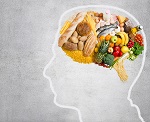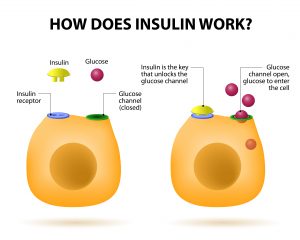
Compiled by June M Chewning
Brain health is directly related to blood sugar levels (glucose homeostasis) in the body.
The information in this article is taken from the American Academy of Sports Dietitians and Nutritionists (AASDN) continuing education course “The Science of Nutrition.”
There are so many misconceptions and misinformation about nutrition. Everyone wants to believe they are eating to properly fuel their body and prevent disease. There is one clear path to learn how to separate fact from fiction when it comes to nutrition information. For some reason, many people prefer to follow the nutrition fads, instead of trying to understand how the body works. The best path to optimal nutrition is to learn how the body responds physiologically to food. When you understand how the body works, then you will understand how to fuel the body properly.
So is breakfast important? Is Breakfast important from a physiological standpoint? What should you eat for breakfast? Let’s explore how the body works to answer these questions.
If we define breakfast as the first meal consumed at the start of our day, then yes, breakfast is very important. As you may have heard, it is the most important meal of the day for most people. One reason why is Glucose Homeostasis.
Glucose homeostasis is one of the highest levels of homeostatic control in the human body. Normal fasting blood glucose in a healthy individual is between 70 and 100 mg/dl. This range is regulated primarily by the hormones insulin, glucagon, epinephrine, and norepinephrine.
 Many cells in the body have insulin receptors which bind insulin allowing glucose to enter the cell. These cells are known as insulin-dependent cells and most cells in the body are insulin dependent. Insulin acts like a key, opening the door so the cell can let the glucose enter.
Many cells in the body have insulin receptors which bind insulin allowing glucose to enter the cell. These cells are known as insulin-dependent cells and most cells in the body are insulin dependent. Insulin acts like a key, opening the door so the cell can let the glucose enter.
Although most cells in the body are insulin dependent, there are also some non-insulin-dependent cells that do not have insulin receptors (red blood cells, nerve cells, cells involved in vision, etc). These non-insulin-dependent cells are quite different in that insulin has either little or no effect on glucose utilization or uptake. Another distinguishing factor is that these cells can only use glucose as an energy source. So nervous system and brain cells, vision cells, and red blood cells need a healthy level of glucose available in the blood stream in order to function properly and remain healthy. They can’t store glucose in the cell, but having glucose available at all times is imperative for proper cell function and cell health.
These cells are particularly at risk for damage when blood glucose levels in the blood stream are not within normal range for any extended period of time. Therefore, prevention of damage to these cells requires glucose levels to be maintained within the homeostatic range. This homeostatic control helps to explain why conditions like Diabetes are so dangerous. If the body is not able to naturally maintain normal blood glucose levels, critical cells in your brain, nervous system, eyes, and blood will be damaged.
The glucose time curve refers to a finite amount of glycogen that can be stored in the body and the processes that occur when glycogen stores are depleted. We know that glycogen is stored in the liver and if adequate carbohydrates are consumed to maximize liver glycogen storage, this glycogen can provide about 12-16 hours of glucose for non-insulin dependent cells. Once this glycogen is depleted the body must produce glucose from other sources.
Let’s say that a normal, healthy individual consumes a healthy, carbohydrate rich meal at 6 pm. The meal should provide adequate glucose for about 4 hours, taking the individual to about 10 pm when this individual goes to bed. During the evening, while sleeping, the body still requires glucose which can be obtained from liver glycogen stores. Assuming this individual gets an adequate 8 hours of sleep, this individual wakes at 6 am and only has about 4 to 8 hours of glycogen remaining in the liver. This makes a healthy, carbohydrate rich breakfast important.
 If breakfast is skipped, then somewhere around 10 am the body starts to search for other means of obtaining the vital glucose to sustain the cells that must have it. The only option is a process called Gluconeogenesis which is the making of glucose from non-carbohydrate sources in the body. The body will break down stored proteins to obtain glucogenic amino acids and convert them to glucose. The body CANNOT make glucose from stored fat.
If breakfast is skipped, then somewhere around 10 am the body starts to search for other means of obtaining the vital glucose to sustain the cells that must have it. The only option is a process called Gluconeogenesis which is the making of glucose from non-carbohydrate sources in the body. The body will break down stored proteins to obtain glucogenic amino acids and convert them to glucose. The body CANNOT make glucose from stored fat.
During gluconeogenesis, the body is getting the needed glucose, but at a very high cost. The nitrogen that is removed from the amino acids must be excreted from the body. Also, the primary location for the body to obtain whole proteins for gluconeogenesis is skeletal muscle. This muscle that we have worked so hard to build and maintain is now being catabolized for survival. This is so dangerous that the body will only allow it to occur for up to 48 hours. At that point, so much damage has been done that the body moves to another metabolic process that steals amino acids form muscle tissue to survive known as Ketosis. However, brain and nerve cells cannot use the “fake” glucose and damage to the brain, blood and nervous system begins.
So, the bottom line? DO NOT SKIP BREAKFAST… skipping breakfast starves and damages your brain, nervous system, blood, and eye cells. It is vital to eat healthy carbohydrates for breakfast, especially if you are going to exercise in the morning, to make sure you have plenty of circulating glucose in your blood to feed your non-insulin-dependent vital cells. Eat a breakfast that includes foods like oatmeal, whole grain breads, whole grain cereal, and fruit. FEED YOUR BRAIN! Preserve it, don’t starve it.
Reference:
American Academy of Sports Dietitians and Nutritionists (AASDN). 2017. The Science of Nutrition. Fitness Learning Systems. www.FitnessLearningSystems.com.


